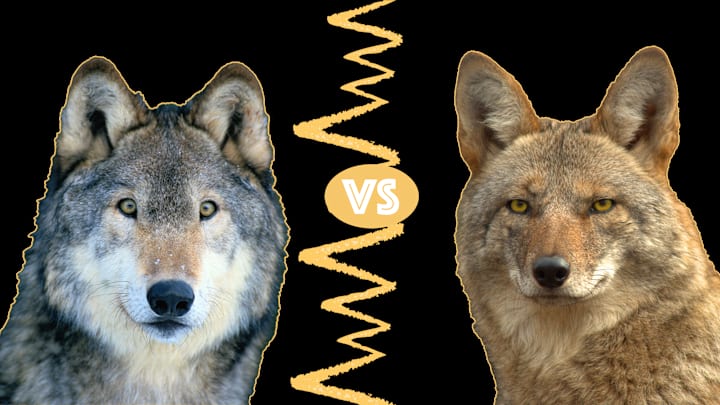Coyotes (Canis latrans) and wolves (Canis lupus) are two closely related species from the dog (Canidae) family. Though they can live in the same habitat and sometimes look alike (from a distance, that is), there are many differences between the two species. Here are a few key ways to tell coyotes and wolves apart.
Species Name | Habitat Range | Size | Color | Facial Features | Sounds |
|---|---|---|---|---|---|
Wolf (Canis lupus) | North America, parts of Europe and Asia | Up to 73 inches long and 30 inches tall | Color can range from light gray to black | Broader faces, block-shaped snouts, and shorter, rounded ears | Howls, growls, barks, and whimper-like vocalizations |
Coyote (Canis latrans) | North America and Central America | 32–37 inches long; 21–24 inches high | Usually grayish-brown | Slender faces with narrow snouts and tall, pointy ears | High-pitched barks, yelps, growls, and howls |
- Physical Differences Between Coyotes and Wolves
- Wolf vs. Coyote Habitats
- Wolf vs. Coyote Social Structure
- What do wolves and coyotes eat?
- Coyote vs. Wolf Sounds
Physical Differences Between Coyotes and Wolves
One of the most obvious differences between wolves and coyotes is their size. From nose to tail, coyotes measure between 32–37 inches long and stand 21–24 inches high. Gray wolves are larger: They can be up to 73 inches long and average about 30 inches tall at the shoulder. Their weight difference is what really stands out—coyotes weigh between 20–45 pounds, while wolves weigh between 50–150 pounds. Coyotes have leaner bodies, with thinner and shorter legs. The females of both species are generally smaller than the males.

Their facial features are different, too. Coyotes have slender faces with narrow snouts and tall, pointy ears; wolves have broader faces, block-shaped snouts, and shorter, rounded ears. Pay attention to their tails as well: Coyotes point their tails downward when walking, while wolves raise them to be in line with their back. Coyote fur is usually grayish-brown; wolf fur ranges from light gray to black.
Wolf vs. Coyote Habitats
Coyotes’ geographic distribution has grown over the past 100 years to include most regions of North America, as well as parts of Mexico and Central America. Their ability to adapt to different habitats has allowed them to thrive in a time where other animals’ ranges are dwindling.
Gray wolves have had their range reduced by about one-third over the centuries, though they are now not considered to be endangered. They’re found predominantly in parts of the Northern Hemisphere including Canada and the northern U.S. (including a thriving population in Yellowstone National Park), as well as small pockets of Europe and Asia.
Wolf vs. Coyote Social Structure
Coyotes have strong social structures that rely on family bonds and shared territory. Packs are usually made up of an alpha male and female and three to eight additional family members, with their size depending on the availability of food and the size of the territory. Alpha pairs are the only ones to mate unless their population is threatened.

Wolf packs also have strong social structures and familial bonds that include an alpha male and female (the only breeding pair), their offspring, and other non-breeding adults. The pack size usually ranges between two to 10 wolves, though those numbers can vary quite a bit [PDF]. Each pack lives in a specific territory; some young wolves will have to strike out on their own at the age of 1 or 2 unless an older member of the pack dies and a spot opens up.
What do wolves and coyotes eat?
Coyotes are omnivorous and opportunistic hunters and scavengers. They’ll eat small animals (like mice, squirrels, rabbits, and birds, among others) as well as local vegetation (grass, berries, fruits, and nuts). They’ll also infiltrate garbage cans or nab small livestock, like chickens or ducks. Coyotes typically hunt alone but sometimes join in loose pairs to take down larger prey.
Conversely, wolves almost exclusively hunt in packs. Hoofed herbivores like moose, elk, and deer are their main prey, though they’ve also adapted to eating a more varied diet that can include rodents, fish, birds, and even carrion or garbage.
Coyote vs. Wolf Sounds
Coyotes make high-pitched barks, yelps, and howls, and are sometimes referred to as barking dogs. Wolves may occasionally communicate using similar bark or whimper-like vocalizations, but they’re most known for their howling. For wolves, howling strengthens the bonds between members of the pack; it also serves as a social rally, hunting or mating call, and a way to communicate during territorial confrontations with other wolves.
Read More Stories About Animals Here:
Have you got a Big Question you'd like us to answer? If so, let us know by emailing us at bigquestions@mentalfloss.com.
